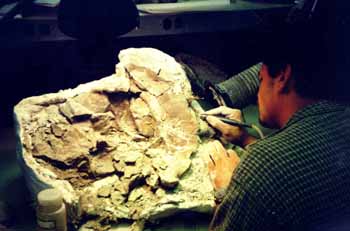
 | |||||||
 In 1997, as part of a
major phase of growth, the Utah Museum of Natural History initiated
a new program focused on vertebrate paleontology. The first step
entailed construction of a fossil preparation facility in the
Museum's newest gallery, the Quinney Discovery Hall, allowing the
public the opportunity to view ongoing preparation and conservation
of fossils. In 1997, as part of a
major phase of growth, the Utah Museum of Natural History initiated
a new program focused on vertebrate paleontology. The first step
entailed construction of a fossil preparation facility in the
Museum's newest gallery, the Quinney Discovery Hall, allowing the
public the opportunity to view ongoing preparation and conservation
of fossils.
In 1999, the UMNH undertook the next step, hiring a Curator of Paleontology (Scott D. Sampson), Collection Manager of Paleontology (Mike Getty), a Curatorial Assistant (Jude Higgins) and a lab technician (Monica Castro). This program has been very active in its short tenure. For example, the Collection Manager currently oversees 50 volunteers working in the collection area and the preparation lab. The department has also just completed its first season of fossil collecting, targeting several productive formations of Late Cretaceous age in Utah. Given that the Cleveland-Lloyd quarry has shown no indication of being depleted, plans are now underway to reopen this site in the summer of 2001, thereby adding to this already extensive collection. The UMNH paleontology collection contains fossil vertebrate, invertebrate, and paleobotanical specimens collected from Utah and surrounding western states, as well as numerous international localities. The collection occupies approximately 6,000 square feet in the basement level of the Museum. The collection includes 4,000 fossil invertebrate specimens, and over 7,000 paleobotanical specimens. The paleobotanical collection includes the most extensive assemblage of Triassic fossil plants outside of the Smithsonian Institution, as well as an extensive collection of fossil leaves and insects from the Green River Formation. The fossil vertebrate collection, the largest of the three paleontology collections at the Museum, exceeds 12,000 specimens, including seven holotype specimens and 15 paratypes. Currently, this collection is dominated by classic dinosaurs from the Late Jurassic, including, but not limited to, fossils of Allosaurus, Ceratosaurus, Stegosaurus, and Camarasaurus.
Specimens collected at this site join
thousands of Cretaceous-aged mammal fossils and associated fauna
including fish, amphibians, and reptiles from southern Utah. Recent
expeditions in the Late Cretaceous outcrops in Grand
Staircase-Escalante National Monument and Manti-LaSal National
Forest have resulted in the addition of significant new dinosaur
specimens to the collections, including Utah's first Tyrannosaurus
rex, several Ceratopsian (horned) dinosaurs, and hadrosaur
(duck-billed dinosaur) remains. Together, these specimens are aiding
research on this important, but poorly known time interval in our
planet's history. Cenozoic Mammals are also well represented, with a
diversity of extinct mammal species from the Uinta and Bridger
Basins, as well as Badlands National Park. Pleistocene mammals in
the collection include an excellent representative sample of the
Bonneville Basin fauna, including mammoth, big horned sheep, musk
oxen, camel, horse, bison, short-faced bear, peccary, fox and
wolf. |
|||||||
| |||||||
The Archaeology collections at the Utah Museum of Natural History date back to the end of the 19th Century. The first artifacts were probably collected by Henry Montgomery, Professor of Natural History at the University of Utah.>>>
Goshute, Navajo, Northwestern Shoshoni, Southern Paiute, Northern Ute, Skull Valley Goshute, White Mesa Ute. These seven distinctive Native nations have lived for centuries on the land that rests within the present-day borders of Utah. more >>>
UMNH has received the prestigious Save America's Treasures (SAT) grant to support the conservation of an extraordinary collection of moccasins recovered at Promontory Cave, Utah, during the 1930's.
more >>>
The Utah Museum of Natural History, in partnership with the University of Utah's Genetic Science Learning Center presents FREE movie screenings followed by lively discussion with an expert in the field. Learn about science and have fun at the same time!
more >>>
 The highlight of the
paleontology collection is the remarkable and extensive dinosaur
assemblage from the Late Jurassic Cleveland-Lloyd quarry, which
includes the world's largest single collection of a single species
of large theropod (Allosaurus fragilis). Additionally, through a
generous donation of land, the UMNH owns a dinosaur site, the Long
Walk Quarry. This significant site occurs in the Early Cretaceous
Cedar Mountain Formation.
The highlight of the
paleontology collection is the remarkable and extensive dinosaur
assemblage from the Late Jurassic Cleveland-Lloyd quarry, which
includes the world's largest single collection of a single species
of large theropod (Allosaurus fragilis). Additionally, through a
generous donation of land, the UMNH owns a dinosaur site, the Long
Walk Quarry. This significant site occurs in the Early Cretaceous
Cedar Mountain Formation. 